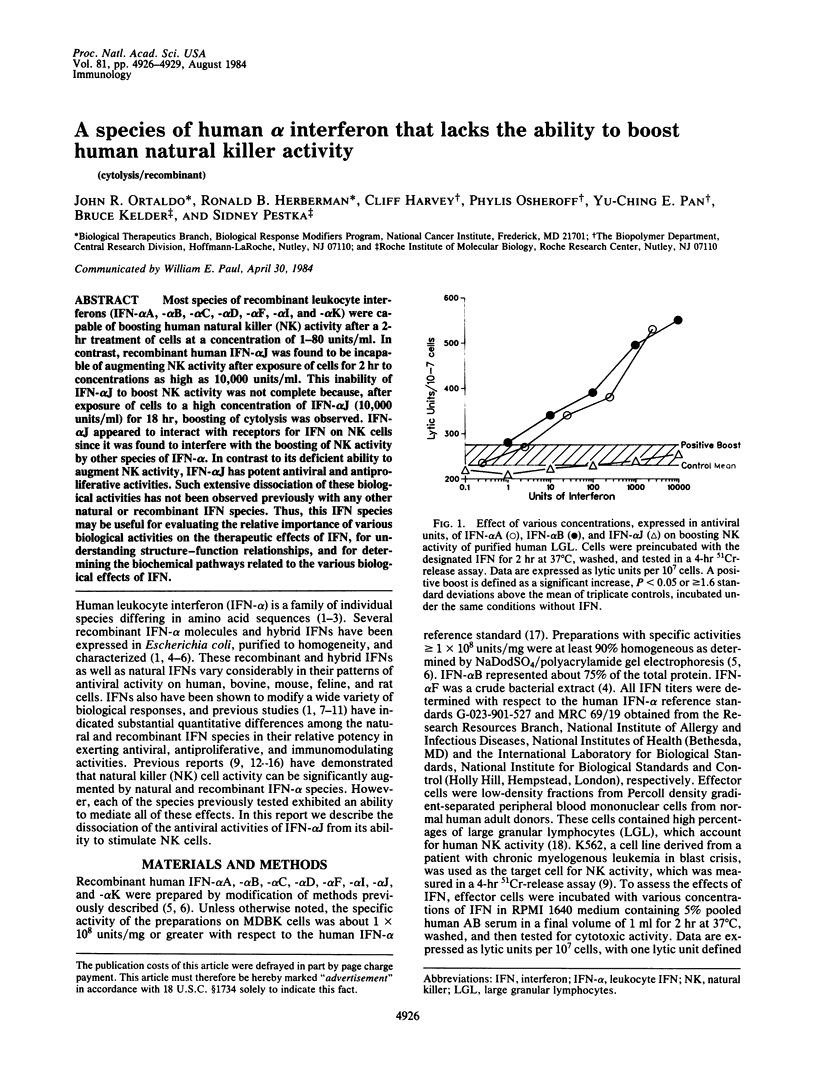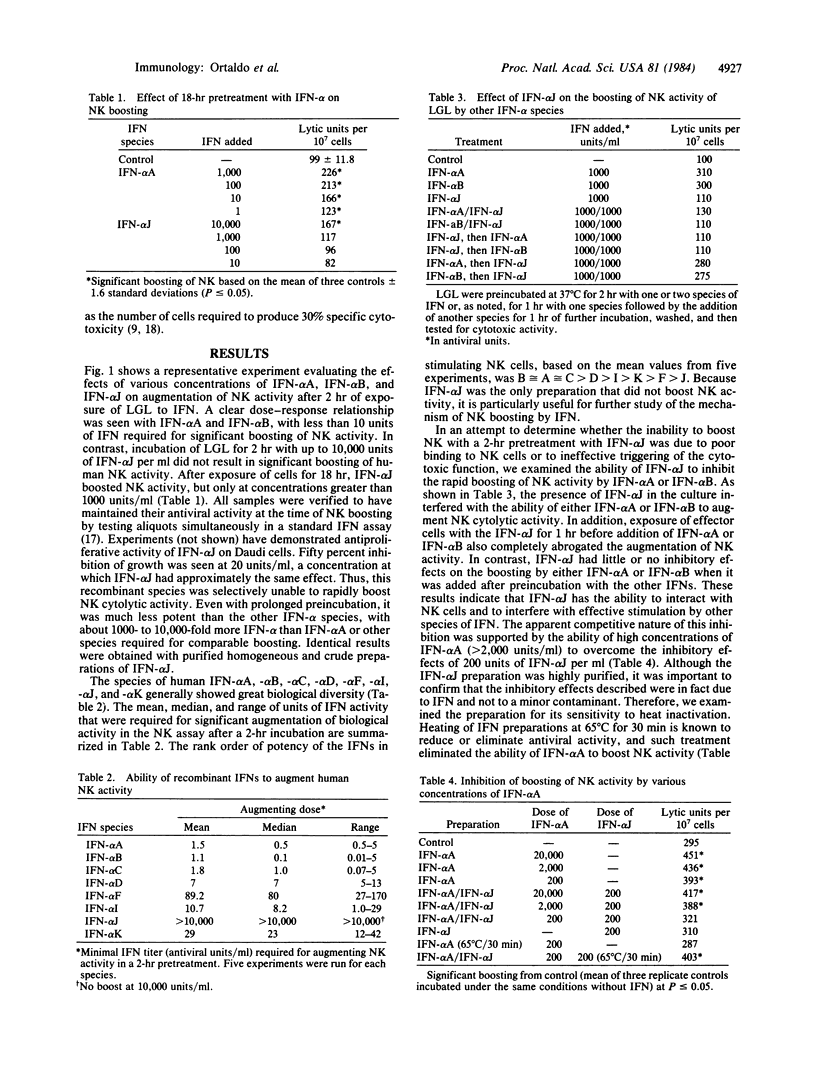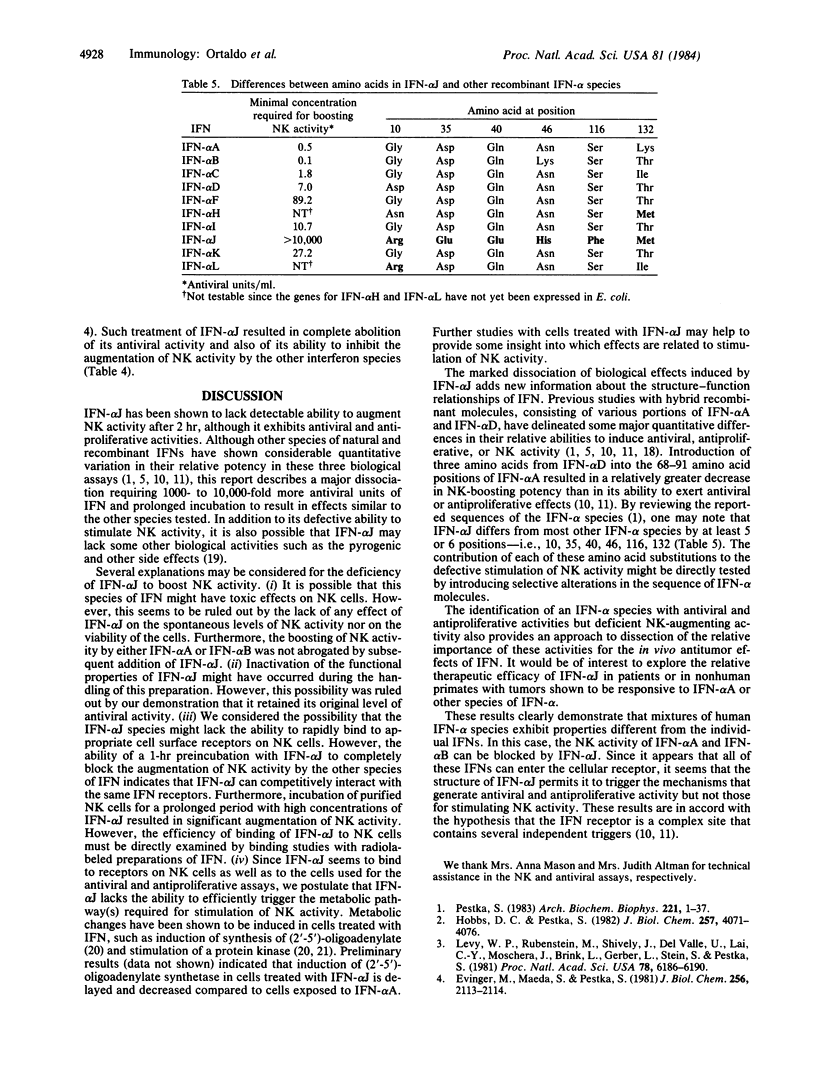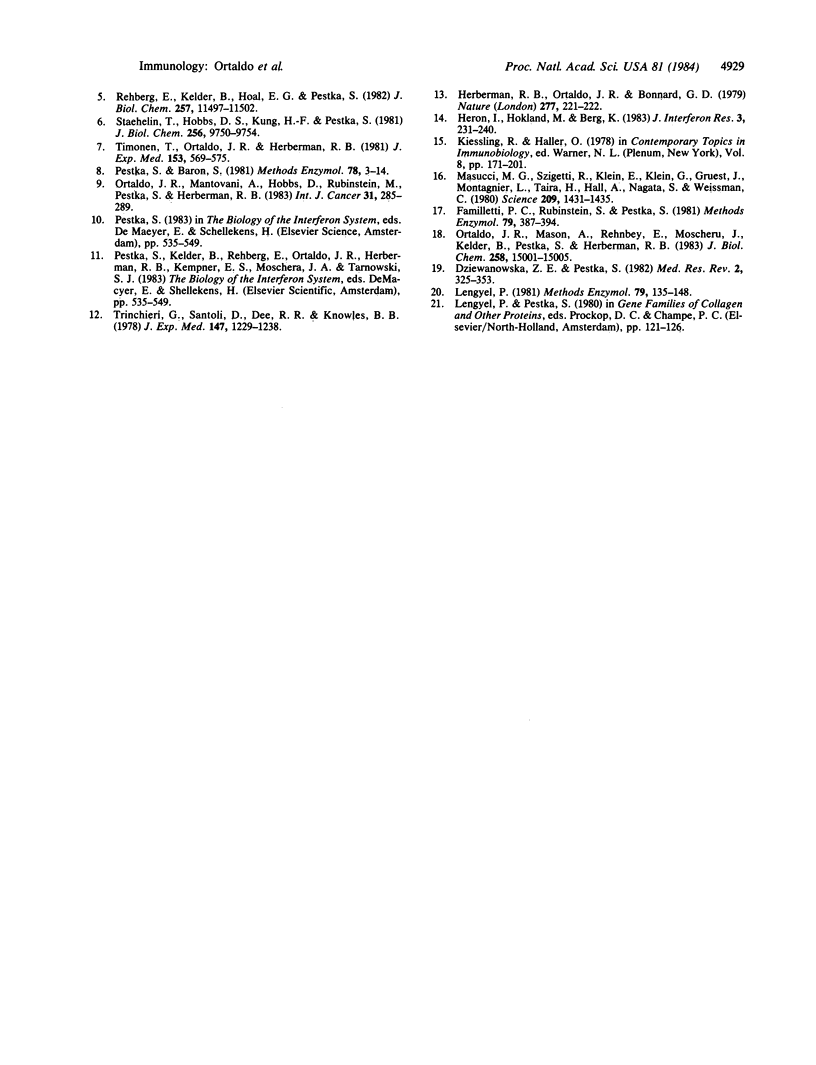Abstract
Most species of recombinant leukocyte interferons (IFN-alpha A, -alpha B, -alpha C, -alpha D, -alpha F, -alpha I, and -alpha K) were capable of boosting human natural killer (NK) activity after a 2-hr treatment of cells at a concentration of 1-80 units/ml. In contrast, recombinant human IFN-alpha J was found to be incapable of augmenting NK activity after exposure of cells for 2 hr to concentrations as high as 10,000 units/ml. This inability of IFN-alpha J to boost NK activity was not complete because, after exposure of cells to a high concentration of IFN-alpha J (10,000 units/ml) for 18 hr, boosting of cytolysis was observed. IFN-alpha J appeared to interact with receptors for IFN on NK cells since it was found to interfere with the boosting of NK activity by other species of IFN-alpha. In contrast to its deficient ability to augment NK activity, IFN-alpha J has potent antiviral and antiproliferative activities. Such extensive dissociation of these biological activities has not been observed previously with any other natural or recombinant IFN species. Thus, this IFN species may be useful for evaluating the relative importance of various biological activities on the therapeutic effects of IFN, for understanding structure-function relationships, and for determining the biochemical pathways related to the various biological effects of IFN.
Full text
PDF



Selected References
These references are in PubMed. This may not be the complete list of references from this article.
- Dziewanowska Z. E., Pestka S. The human interferons. Med Res Rev. 1982 Oct-Dec;2(4):325–353. doi: 10.1002/med.2610020403. [DOI] [PubMed] [Google Scholar]
- Evinger M., Maeda S., Pestka S. Recombinant human leukocyte interferon produced in bacteria has antiproliferative activity. J Biol Chem. 1981 Mar 10;256(5):2113–2114. [PubMed] [Google Scholar]
- Familletti P. C., Rubinstein S., Pestka S. A convenient and rapid cytopathic effect inhibition assay for interferon. Methods Enzymol. 1981;78(Pt A):387–394. doi: 10.1016/0076-6879(81)78146-1. [DOI] [PubMed] [Google Scholar]
- Herberman R. R., Ortaldo J. R., Bonnard G. D. Augmentation by interferon of human natural and antibody-dependent cell-mediated cytotoxicity. Nature. 1979 Jan 18;277(5693):221–223. doi: 10.1038/277221a0. [DOI] [PubMed] [Google Scholar]
- Heron I., Hokland M., Berg K. 13 native human interferon-alpha species assessed for immunoregulatory properties. J Interferon Res. 1983;3(2):231–239. doi: 10.1089/jir.1983.3.231. [DOI] [PubMed] [Google Scholar]
- Hobbs D. S., Pestka S. Purification and characterization of interferons from a continuous myeloblastic cell line. J Biol Chem. 1982 Apr 25;257(8):4071–4076. [PubMed] [Google Scholar]
- Lengyel P. Enzymology of interferon action--a short survey. Methods Enzymol. 1981;79(Pt B):135–148. [PubMed] [Google Scholar]
- Levy W. P., Rubinstein M., Shively J., Del Valle U., Lai C. Y., Moschera J., Brink L., Gerber L., Stein S., Pestka S. Amino acid sequence of a human leukocyte interferon. Proc Natl Acad Sci U S A. 1981 Oct;78(10):6186–6190. doi: 10.1073/pnas.78.10.6186. [DOI] [PMC free article] [PubMed] [Google Scholar]
- Masucci M. G., Szigeti R., Klein E., Klein G., Gruest J., Montagnier L., Taira H., Hall A., Nagata S., Weissmann C. Effect of interferon-alpha 1 from E. coli on some cell functions. Science. 1980 Sep 19;209(4463):1431–1435. doi: 10.1126/science.6158096. [DOI] [PubMed] [Google Scholar]
- Ortaldo J. R., Mantovani A., Hobbs D., Rubinstein M., Pestka S., Herberman R. B. Effects of several species of human leukocyte interferon on cytotoxic activity of NK cells and monocytes. Int J Cancer. 1983 Mar 15;31(3):285–289. doi: 10.1002/ijc.2910310306. [DOI] [PubMed] [Google Scholar]
- Pestka S., Baron S. Definition and classification of the interferons. Methods Enzymol. 1981;78(Pt A):3–14. doi: 10.1016/0076-6879(81)78091-1. [DOI] [PubMed] [Google Scholar]
- Pestka S. The human interferons--from protein purification and sequence to cloning and expression in bacteria: before, between, and beyond. Arch Biochem Biophys. 1983 Feb 15;221(1):1–37. doi: 10.1016/0003-9861(83)90118-2. [DOI] [PubMed] [Google Scholar]
- Rehberg E., Kelder B., Hoal E. G., Pestka S. Specific molecular activities of recombinant and hybrid leukocyte interferons. J Biol Chem. 1982 Oct 10;257(19):11497–11502. [PubMed] [Google Scholar]
- Staehelin T., Hobbs D. S., Kung H., Lai C. Y., Pestka S. Purification and characterization of recombinant human leukocyte interferon (IFLrA) with monoclonal antibodies. J Biol Chem. 1981 Sep 25;256(18):9750–9754. [PubMed] [Google Scholar]
- Timonen T., Ortaldo J. R., Herberman R. B. Characteristics of human large granular lymphocytes and relationship to natural killer and K cells. J Exp Med. 1981 Mar 1;153(3):569–582. doi: 10.1084/jem.153.3.569. [DOI] [PMC free article] [PubMed] [Google Scholar]


